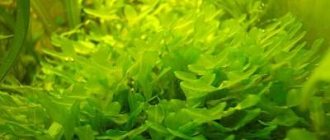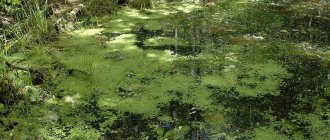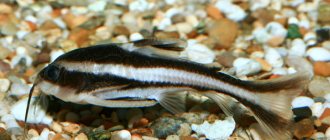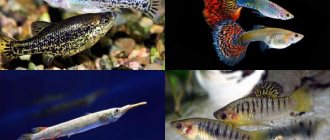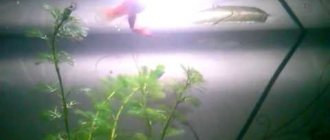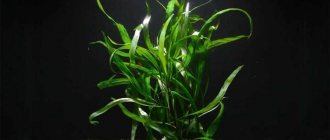A great way to decorate a natural aquarium while adding a natural touch is to use mosses. Almost all types of mosses get along well in aquarium conditions, and they are also easy to care for. Dark green mosses combine well with other plants , highlighting their natural beauty. They also look great against the background of various decorative elements, such as driftwood or stones. But despite the fact that aquarium mosses, or rather many of its species, are considered unpretentious, you need to know how to properly care for them. This will be discussed in more detail in this article.
Aquarium moss
Botanical description and natural habitat
Bryophytes (Bruophyta) are a huge section of higher plants, numbering more than twenty thousand species. They are united in more than 700 genera and 120 families. These are the oldest inhabitants of our planet, they are more than three hundred million years old.
Bryology deals with the study of Bryophytes; this is a large branch of botany.
Mosses are spore-bearing plants. According to a scientific point of view, they descended from psilophytes (extinct land plants), which, in turn, are descendants of even more ancient forms of fauna dating back to the end of the Devonian - the beginning of the Carboniferous period of the Paleozoic era.
Bryophytes lack flowers, roots, and a conducting system. Reproduction occurs with the help of spores that mature in a special sporangium organ in the diploid multicellular phase in the sporophyte life cycle of the plant.
Photo gallery Mkhov:
The sporophyte or sporogonium of mosses has a simpler structure than that of other higher plants. It does not take root and consists directly of the sporangium itself, the leg that supports it, and the foot associated with the gametophyte (produces gametes - special germ cells).
These are mostly small plant formations (up to 45-50 mm), but aquatic species can be much larger (about 50-70 cm).
Mosses are found on all continents of our planet, even in Antarctica. They grow in dense colonies in shaded areas near water or in fresh environments (they do not grow in marine environments). But swamps are very fond of these plants and often contribute to their spread through their growth.
In the tundra, mosses completely cover the soil and create their own biocenosis (an environment for the development of various living organisms).
These unique plants are able to absorb and retain water, as well as absorb radioactive substances. A dense carpet of mosses often makes it difficult to work on agricultural land, but it protects the soil from erosion.
Some sphang varieties of mosses are used in medicine; in addition, peat is formed on their basis. Moss is an excellent insulation material for building houses, and when growing many garden and indoor plants, it serves as a kind of filler.
Conditions for breeding
These breeding conditions are mandatory regardless of what species are used for decoration; mosses require approximately the same temperature conditions.
- The ideal temperature for maintaining the created composition of spore plants is from 20 to 25 °C.
- It is important to add nitrates and phosphates only when absolutely necessary.
- Keep the inside of the aquarium clean and periodically remove all accumulated debris.
- When growing plants, new branches must be removed, otherwise the moss that has grown on them will contribute to the death of the lower branches.
- There must be aquarium soil, as it plays an important role for all plants and inhabitants, as well as mosses, being a “natural filter” that cannot be replaced by anything.
Mr. Tail recommends: varieties of aquarium mosses
Conventionally, based on where they grow, mosses are divided into three large groups:
- Antocerova. Distinguished by its leaves in the form of plates, this species most often grows in tropical zones.
- Liverworts. This is the most widespread moss, found everywhere. These plants have small and delicate leaves and minimal height.
- Leafy. A very large group that includes the following mosses: Andreevy, Brievy, Sphangate.
Here we consider only some of the varieties of mosses that are most often used in modern aquarium farming for decorating artificial reservoirs.
Riccia
This floating plant lacks stems and leaves. A conventional bush consists of small intertwined plates. If Riccia floating is planted on the bottom of a tank, it quickly creates a dense green carpet in which fry like to hide and many species of underwater inhabitants spawn.
A healthy plant has a light green color; when the conditions deteriorate, the plates acquire a reddish tint. Requires good lighting and low water hardness.
In nature, it grows everywhere, but is most often found in temperate climate zones.
Taiwanese mosses
The scientific name of these aquatic plants is Riccardia chamedrifolia. They were discovered for the first time only in 2005 in Taiwan; in addition, they also grow in South American reservoirs.
In general, this is an unpretentious aquarium plant, but to prevent rotting of the lower layers, it must be trimmed regularly.
This liver creeping species is densely green in color with fleshy stem-legs, barely reaching a height of 4 cm, loves bright light and additional replenishment of carbon dioxide.
Moss Phoenixes
They have the second name Fontanus because of the peculiar shape of the plant, similar to a fountain. They belong to the Fissidentaceae and have more than four hundred species. The word "Fissidens" is translated as "dissected tooth."
The homeland of the species is North America, but now it grows widely in Africa, Europe, Japan, and Thailand. This is where the name Phoenix came from because of the comparison of the bush with the bushy tail of a bird of paradise.
Narrow leaves up to 2 mm in length, bush height about 2-3 cm.
It grows very slowly, loves clean water, but does not need feeding or securing, and easily takes root on any surface.
Java Mosses
They belong to the Hypnidae family. The homeland of the species is Malaysia, India, Java.
The blade of small (0.5 cm) leaves is narrow and pointed, light green in young shoots, darker in an adult bush, reaching a height of 15-17 cm.
Instead of roots, Java mosses have rhizoids. These are special formations that stick to any surface and allow Moss to firmly attach itself.
Mosses of Pelia
Or Monosolenium tenerum, which belong to the hepatic class of mosses. They are very similar to Floating Riccia in structure, but in nature they grow mainly in Asian reservoirs.
Easily forms spherical bushes with leaves 5-10 mm wide and up to 2 cm long, there are rhizoid suckers.
Does not require special fertilizing and fertilizers, it is fragile.
Exotic decorative mosses
This group of moss-like plants is not so widespread among amateurs; they are most often used in their work by aquascapers.
Key mosses
Fontinalis hypnoides belongs to the Rodnikov family. They are distinguished by their rare beauty and effectiveness. Distributed everywhere, they do not grow only on the Australian continent.
Aquarists often transplant Key mosses from local rivers, lakes and ponds into artificial home ponds. This type of aquatic plant grows in dark green lacy thickets and serves as an excellent decoration and refuge for young fish.
The stems of Moss are branched and, under optimal aquatic conditions, reach 50-60 cm in length. The leaves are oval-shaped, pointed towards the end of the plate. Its dimensions are 10x5 mm.
The color and shape of Key mosses depend on environmental conditions; their color can range from dark green to deep red.
Rhizoids, replacing roots, allow algae to attach to any surface without directly needing soil, and receive nutrients.
To fix it, just press Moss onto an uneven porous surface and leave it there for 3-4 months.
The periods of active growth of the plant are seasonal, it grows quickly in the summer, subject to a temperature of +24...+29 °C, and in the winter it needs rest at +10...+12 °C. It is for this reason that not every aquarist can breed this Moss; if this condition is not met, then next spring the algae will simply die.
Acidity and hardness are not so important, but in soft water Key moss develops better. A clean environment and the correct choice of fish in the aquarium are important.
Characins, carp-toothed and small viviparous ones are preferable, but large ones and catfish, digging through the bottom filler, can destroy the plant.
The lighting should be dim and diffused, covering the moss from direct sunlight, which is harmful to the sprouts. Daylight hours should not be longer than 10-12 hours.
Christmas mosses
Christmas-Moss are so named because the young shoots resemble the branches of a Christmas tree, growing downward and overlapping each other.
The homeland of the species is tropical Asian reservoirs and their shaded areas. The leaf blades are round in shape, their tips are short and pointed.
The original walls in the aquarium, grown from Christmas mosses, look beautiful.
Moss Flame
Flame Moss belongs to Taxiphyllum (thalli). The leaves of an adult plant curl and resemble a candle flame in their shape. The intensity of the curl is related to the hardness of the water. This type of Asian plant is unpretentious in terms of conditions and reproduces easily.
It has long, spirally twisting stems, growing up to 8-9 cm in height and 10-11 cm to the sides.
To fix Moss Flame to decoration elements, it must be attached using fishing line, thread or fine mesh. After just 14 days, the plant begins to grow rapidly, and stones and driftwood with sprouts can be moved, creating interesting compositions.
This type of Moss needs clean water with a temperature of +19...+28 °C, hardness 5-10 dH, acidity 5.5-8 pH. You cannot plant a plant in a newly launched aquarium; it is better to place it in an “old” tank with an established aquatic environment.
They go well with shrimp, excellent cleaners of plant branches from lower algae and suspended matter. Feeding with carbon dioxide and a slight flow in the tank is ideal; it does not like silting.
Weeping mosses
Vesicularia ferriei - Weeping Moss or Weepings are quite often used in modern aquarium keeping. It grows, living up to its name, resembling streams of tears.
The homeland of the species is China, the maximum height of the bush is small (up to 3-4 cm), and the width is slightly larger (5-6 cm).
The plant is secured with fishing line or netting most often on decorative elevations, since weeping branches look better this way.
Adaptation takes several weeks. Moss needs low light, temperature +21...+28 °C, carbonate hardness 3-8 kH, acidity 7-9 pH, excellent filtration, replenishment with carbon dioxide and mineral fertilizers. In addition, to preserve the lower shoots, regular pruning is preferable.
Cameroon mosses
Plagiochilaceae sp. Cameroon moss comes from the black continent. It belongs to the Liver mosses and is perhaps their most outstanding and spectacular species due to its small oval leaves and neatly shaped bushes. This very unassuming variety recognizes good lighting and loves to be fed with carbon dioxide. The quality and intensity of light allow Cameroon to acquire various variable modifications in color and shape.
These are fairly large leaf-stemmed mosses that easily grow to any surface and form lush bushes that serve as a biofilter for the tank and a refuge for small fish and juveniles.
Optimal temperature is +21…+28 °C, illumination not lower than 75 Lm/l, carbonate hardness 0-8 kH, acidity 5-7 pH.
A clean and transparent water environment is needed, which is ensured by good filtration and frequent fluid changes.
Cameroon grows quite slowly; mineral fertilizing can speed up this process, but it is important not to allow its excess.
Singapore mosses
Singapore Moss (Vesicularia dubyana) is an inexpensive and already quite common Asian Moss, very similar to Java Moss.
The bush is elongated, pale green in color, triangular branches are feathery, creeping. These are very hardy mosses; their land varieties survive even under the scorching rays of the sun.
It is unpretentious in terms of hardness and acidity of the aquatic environment, but does not like strong lighting. When fertilized with mineral fertilizers and carbon dioxide, it grows quickly. The desired temperature is within +17…+28 °C.
If you cut a twig or break off part of the bush, then this fragment will easily take root on any substrate.
Carpet mosses
Griff Moss is quite capricious in terms of keeping conditions, grows very slowly, does not like strong light (blackening of the leaf blade occurs), and responds well to the supply of carbon dioxide. It easily takes root on any surface and reproduces.
Anchor mosses
Anchor Moss belongs to Taxiphyllum. They grow slowly, do not adhere to surfaces, and are attached using rhizoids. The optimal temperature is within +14...+28 °C, acidity 4.5-7.5 pH, any illumination and carbon dioxide replenishment.
Brazilian mosses
Brasil Moss is named after its native habitat. They are very rare in modern aquarium keeping, as they have been studied very little.
Optimal maintenance conditions are water temperature +14...+26 °C, acidity 5.5-8 pH, hardness 1-24 dH, moderate or slightly higher illumination. It is characterized by slow and difficult growth in artificial reservoirs.
Blepharostomy mosses
Blepharostoma trichophyllum has been studied very little and is poorly distributed in modern aquariums. The optimal water temperature is +19…+26 °C, area 6-7.5 dH, any acidity and degree of illumination.
Chinese mosses
China-moss are still widely distributed in aquariums only in their native country of growth; they have been little studied and are extremely rare.
standing mosses
Erect Moss got its name due to the fact that the stems of the bushes take a vertical position under water, standing in columns. They love bright lighting, clean water, and feeding with carbon dioxide.
Weeping
The name of this moss, a photo of which you can enjoy below, owes much to the structure of its branches, which in many ways resemble a weeping willow. It was brought to Europe from China. Maximum height is about 50 mm. As practice shows, this moss has proven itself excellent for placement on various pebbles or driftwood. A comfortable temperature for its maintenance ranges between 15-28 degrees.
Aquarium Basics
Most often, novice aquarists consider Mosses to be the algae that need to be gotten rid of. This only shows that these amateurs do not understand the importance and role of these plants in an artificial reservoir.
Another misconception is that you don’t need soil in an aquarium with Mosses. But this is far from true. The plant has no roots and grows to any surface, does not like suspensions, but receives nutrients from the environment. The presence of a bottom filler, which in itself is a powerful biological filter and a source of beneficial bacteria, is important here.
Mosses need different illumination depending on the variety. Many prefer shaded areas, others need a lot of light. If this parameter is selected correctly, the bushes will grow lush and have bright colors. Typically average values are around 0.5 Watt/L.
This type of aquatic vegetation, which does not have a root system, does not need frequent feeding, but loves saturation with carbon dioxide. Due to the slow growth of Mosses, the main thing here is to avoid an overabundance.
Bryophytes also combine well with other plants, such as Marsilia, Eleocharis, Echinodorus, Cryptocoryne, Blyx, Bucephalandra and Anubias.
Hardness, acidity and water temperature are also different for various species of Mosses, although the adaptability of these plants is very high. Usually it is +15…+29 °C. It should be remembered that excessive softness leads to yellowing of the leaf blades, and insufficient softness can result in the death of the plant.
An important indicator for moss growers is the purity of the water, so it is necessary to replace part of the liquid in a timely manner and maintain good filtration conditions.
In general, caring for mosses is not difficult, you just must not forget about timely trimming the bushes, this is necessary not only for the formation of beautiful forms, but also for the removal of dead fragments.
Key
Another name for this moss is Fontinalis antipyretica or Fontinalis. Widely distributed almost all over the world with the exception of Australia. These mosses, photos of which are quite often found both in school textbooks and in scientific publications.
They have branching stems on which there are a huge number of small leaves. Its color largely depends on both the light intensity and the composition of the soil and can vary from deep red to dark green. As for the content, a tropical or moderately warm artificial pond is ideal for it.
It is also worth noting that these mosses require special treatment. Thus, the temperature of the water environment should not leave the limits of 24-28 degrees in the summer and 10-12 degrees in the winter. You should also be especially careful to ensure that no algae appears on the moss leaves. To avoid this situation, it is recommended to change about 2% of all water in the aquarium weekly. It is worth emphasizing that these mosses are very sensitive to light. Therefore, it is advisable to keep the lighting fairly moderate. But, despite all the difficulties of caring for it, the final result will exceed all even very bold expectations.
Important! Key mosses are perfect for placing in the foreground of an artificial pond.
Common mistakes made by aquarists
Reasons that often cause the death of moss grass in an artificial home tank:
- Complete absence of soil. This natural biological filter is necessary for adequate nutrition of Mosses.
- Combination of Mosses and various types of mollusks. These underwater inhabitants actively eat moss fish.
- Association of mosses and large species of higher aquatic plants. They just start competing with each other.
- Introducing overly aggressive, predatory, bottom-dwelling and herbivorous fish into the tank with Mosses, actively destroying these plant forms.
What is the life cycle of sphagnum moss
Like vascular representatives of the flora, the species in question alternates between the asexual generation (sporophyte) and the sexual generation (gametophyte). The latter is represented by a photosynthetic green plant. Gametes are formed in the genital organs (gametangia). Male gametangia are called antheridia, female gametangia are called archegonia.
From the zygote (fertilized egg) a sporophyte emerges - the spore generation. Mossy plants have virtually no chlorophyll. Sporophytes remain attached to the gametophyte, receiving nutrition from it. Each cell contains a diploid (double) chromosome set. The gametophyte has a haploid (single) chromosome structure (as in gametes).
From two single sets, when the sperm and egg merge, one double set is formed. It is necessary for the development of the sporophyte. During spore formation, meiosis (reduction-type cell division) occurs. As a result, each spore again becomes haploid. Then it can germinate into the same single gametophyte.
Useful properties, benefits of mosses
These unpretentious aquarium plants perform a number of important functions and have the following advantages:
- They are unpretentious and adapt to any living conditions quite easily.
- They grow slowly, which allows them to be grown competently, creating planned combinations.
- Freely grown in containers of various shapes and sizes.
- They add naturalness and completeness to any type of decorative aquarium design.
- They easily move to different places in the tank, as they do not have a root system.
- They act as a shelter and spawning site for many living underwater forms.
- They reproduce without difficulty as a result of the fact that this process occurs through spores.
Lomariopsis lineatu
These mosses, photos of which are posted below, are common in China, Australia and Malaysia. At a quick glance, it can be confused with the hepatic one, but upon repeated examination, its less elongated structure of the processes and the absence of centrally located veins on them immediately catch the eye. And this is not to mention the lighter green color. The use of this moss has proven itself most clearly when tying it with a nylon thread to driftwood and stone. It's worth noting that since this moss grows quite slowly, you shouldn't expect to get gorgeous green mounds after the first week. If Lomariopsis lineatu grows greatly, it will become an excellent refuge for fry or other small fish.
Reproduction and planting of mosses
Mosses are very easy to plant or propagate by simply breaking off a twig or part of a bush and securing this fragment in the right place using fishing line, threads, superglue or fine mesh.
It is better to choose a porous surface, then the rhizoids will easily attach and allow the sprout to fix well.
The main thing for the successful reproduction of moss beetles is a clean aquatic environment. To ensure this parameter, good filtration is needed, replacing part of the liquid every week and special treatment.
Monosolenium tenerum
This moss, the photo of which is simply mesmerizing in its beauty, is quite problematic to find in the wild. As a rule, it is grown in small colonies located in China, India, and Taiwan. Remarkable is the fact that these mosses are completely devoid of leaves. I would also like to emphasize that Monosolenium tenerum is quite easy to grow, and given its lightness, it fits perfectly on the surface of the water, covering the entire free area during the flowering period.
Remember that during transportation these mosses can sink almost to the very bottom of an artificial reservoir. Also, to create an excellent push, some aquarists tie it with a transparent fishing line to snags or stones, which will create additional difficulties in changing its position during water fluctuations.
Moss decorations
Decorating an aquarium with moss allows you to create unique and spectacular underwater pictures. But this process requires hard work, thoroughness, it is very painstaking work.
Superglue, special threads, fishing line, and fine-mesh mesh are used for fixation.
When using glue, the composition is made outside the tank so as not to kill fish and other underwater inhabitants. In this case, the moss needs to be regularly sprayed with water and not allowed to dry out.
To create underwater compositions from Moss, you will also need other available means and tools: scissors, a sharp (for example, stationery) knife, special holders.
They try to distribute mosses over the selected surfaces in an even layer, avoiding layering of branches and creeping them on top of each other.
In order for the composition to look good, it is important to follow the following rules:
- Correctly adjust the nitrogen balance.
- Provide the necessary lighting.
- Regulate the cleanliness of the environment by timely updating of part of the volume and high-quality filtration.
- Timely use additional saturation with carbon dioxide and small doses of micro- and macro-fertilizer.
- Choose the right neighbors. For example, neons and tetras, swordtails, platies, mollies and, of course, shrimp, the true cleaners of these plants. Cichlids, algae eaters, and goldfish should be excluded.
The most popular among modern aquarists are compositions such as “Dense Forest” or “Underwater Slide”; a simple green wall also looks very beautiful.
The most famous decorator of artificial reservoirs in the world of today's aquarium hobby is Takashi Amano. It was he who introduced methods for saturating the reservoir with carbon dioxide, the use of natural shrimp aquatic organisms, special filtration systems and water conditioners, and many others.
The Japanese landscape photographer and aquarium artist created many unique aquascape paintings using Mosses and other aquatic plants, recreating the Amazon jungle, Chanthaburi mangroves, and underwater gardens of Zen temples.
Leptodiccium coastal
This plant got its name because of its long stems (50mm-400mm), located quite far from each other, as shown in the photo.
It is precisely because of their original appearance that these mosses are quite difficult to confuse with other representatives of this group. What’s interesting is that even if initially its stem is directed horizontally, after some time it will still become vertical, creating a unique airiness effect that is so impressive to anyone who looks at it.
Leptodiccium coastal is quite unpretentious in care. Feels comfortable in both standing and flowing water. You can place it on wood, stones or even the ground. The temperature regime ranges from 18-28 degrees.
Diseases and pests
Mosses are very hardy and unpretentious plants, not susceptible to diseases and pests. They can suffer from gross violation of maintenance conditions, untimely pruning of dead fragments and incorrectly selected neighboring flora and fauna.
Lower forms of algae, such as blue-green and blackbeard, pose a particular danger to moss grass.
At the very beginning of the growth of these parasites, Mosses can be saved by moving them to another tank and introducing shrimp to them. The main aquarium needs to be thoroughly disinfected and restarted.
Aquarium design process
It is very labor-intensive, especially if you use decorative or delicate species. All plants that cling well to the surface can be tied with threads. Mosses that do not attach well to the bottom or internal decorations (snags, stones) are best tied with fishing line, as the threads will rot in water.
All mosses can be attached using superglue. This is especially helpful when you need to attach moss in a non-standard place or create an original composition, although here you need to know special subtleties so as not to poison the fish. When decorating, you need to periodically spray the moss with water.
These magnificent plants will decorate any aquarium. It is important to follow the rules of their maintenance, and they will delight the observer for a long time.
Interesting facts about mosses
Many interesting facts are known about these unique ancient plants of the Earth:
- Moss mushrooms are one of the few forms of terrestrial fauna that grow on absolutely all continents of the planet.
- Even moss, which is food for reindeer, is also one of the varieties of mosses.
- Without a root system, mosses absorb nutrients from their environment with their entire surface.
- It grows only in humid areas, so it does not exist in desert areas.
- Reproduces sexually and with the help of spores.
- The only other species on Earth that are older than mosses are algae. But it was the ancestors of the moss grass that became the first terrestrial forms of plants 400 million years ago.
- Mosses do not have flowers.
- This plant can come to life even after complete freezing. Thus, a piece of Moss found in Antarctica, frozen into ice more than 1.5 thousand years ago, came to life when defrosted.
- The most diverse and numerous forms of Mosses grow in trails and wet forests.
- The appearance of peat in swamps occurs due to mosses.
- Moss decoration originated in ancient China.
- Sfangnum peat mosses continuously die off (lower parts) and grow (by a millimeter per year) and their total lifespan is more than 2 thousand years. In other species it is at least 10 years.
Java moss
Java moss is a plant belonging to a small genus.
On sale it can be seen in 10 varieties. This algae does not require special lighting, fertilizers, or feeding, but it is recommended to make the water neutral acidity 16-30℃. Java moss has narrow, flattened shoots with lateral shoots and grows vertically. In home aquariums it can be seen in the background.
The disadvantage of Java moss is that it does not adhere to the ground, so it must be tied down.
Application
Java moss in an aquarium can be used in two forms: utilitarian and decorative. The first case is, first of all, its use in fish breeding. It is a favorite substrate for spawning of many phytophilic fish, very favorable due to its sponge-like structure and because of its specific gravity heavier than water, so that it often does not even require any fixation in the spawning tank. Fish like Java moss; this has long been noticed by fish breeders.
In many amateur decorative aquariums, frequent spontaneous spawnings of various fish, mainly characins and cyprinids, as well as iris, occur. Most often, the eggs are eaten by neighbors, but if there is Java moss in the aquarium, part of the eggs remains and develops into fry, which also find shelter and food in the dense thickets of moss. They create a very favorable biological environment, with good oxygen saturation and various microorganisms, primarily ciliates, which serve as the first food for the fry.
Aquariums decorated with large amounts of Java moss can be used to raise some fish species on a fairly large scale. For example, almost all types of rainbow fish. The same applies to some species of egg-laying carp-toothed fish, which lay their eggs on plants. In aquariums with fish of these species, Java moss is practically “clogged” with fertilized eggs. It is enough to transfer the moss with eggs into a separate incubator aquarium at certain intervals, replacing it with fresh one.
Decor of driftwood and stones
The use of Java moss for decorating an aquarium is very diverse. The most effective way is Java moss on driftwood or stones.
A thin layer of moss is laid out on a driftwood prepared in a certain way and tightly wrapped with some kind of thread. For several weeks, the moss grows to the surface of the driftwood and covers the bald spots. The driftwood takes on a decorative appearance. Bolbitis or microzorium ferns, as well as anubias, are often planted with it. After some time, the plants grow, sprout into each other, representing a first-class example of an underwater landscape, while requiring practically no attention from the aquarist.
To grow onto driftwood, Java moss is carefully laid out on the surface of the driftwood in a thin layer and tied with a very thin fishing line or cotton thread. For several years, such driftwood does not require alteration and only gets better from year to year. When decorating driftwood with Java moss, it is necessary to take into account several nuances: firstly, the moss should be spread over the surface of the base very thinly, almost twig to twig, avoiding dense lumps. Secondly, it must be wound tightly to the surface of the driftwood, without gaps. In this case, you can use a thin fishing line, which then needs to be removed, or you can use a cotton thread, which does not require removal. After a few weeks, the thread rots and falls apart on its own. In a similar way, you can decorate not only driftwood, but also any other objects: coconut shells, rubber hoses of bottom sprayers, etc.
Decor of the back walls of the aquarium
Java moss is used in aquarium design to decorate the back walls of the aquarium. To do this, a coarse mesh made of thin fishing line is attached to the back wall of the aquarium, behind which moss is placed. In addition, anubias and ferns can be planted along the back wall. After some time, this wall will look very natural and beautiful.
You can decorate the bottom of the aquarium in a similar way. Java moss is laid between two layers of fine mesh and the edges are sewn together with fishing line. After some time, the plant will grow and completely hide the base. This is a fairly rarely used, but very effective technique.
Java moss can be used above water to decorate paludariums and wet greenhouses. To do this, a piece of moss is placed at the water's edge on gently rising ground. Sometimes the plant “comes out” of the water on its own, growing on decorative stones and snags.
Hornwort
Hornwort dark green
Well, the last plant that we will need temporarily, at the first stage of the life of the aquarium, is the common hornwort. Big good bun. This unpretentious cosmopolitan plant, not distinguished by high aesthetic qualities, has one very important property for the successful start of an aquarium - it grows very quickly. So quickly that in the starting period, when the permanent plants are still sick, taking root and experiencing stress from transplantation, it takes over the initiative and does not allow lower algae to develop, starting the biochemical cycle of the aquarium.
Hornwort light green
Aqua Logo Andrey Klochkov
To be continued…
The first part is devoted to preparing a “slow aquarium”, the third - the process of creating it, and the fourth - suitable fish for it.
Fields marked with * are required.
